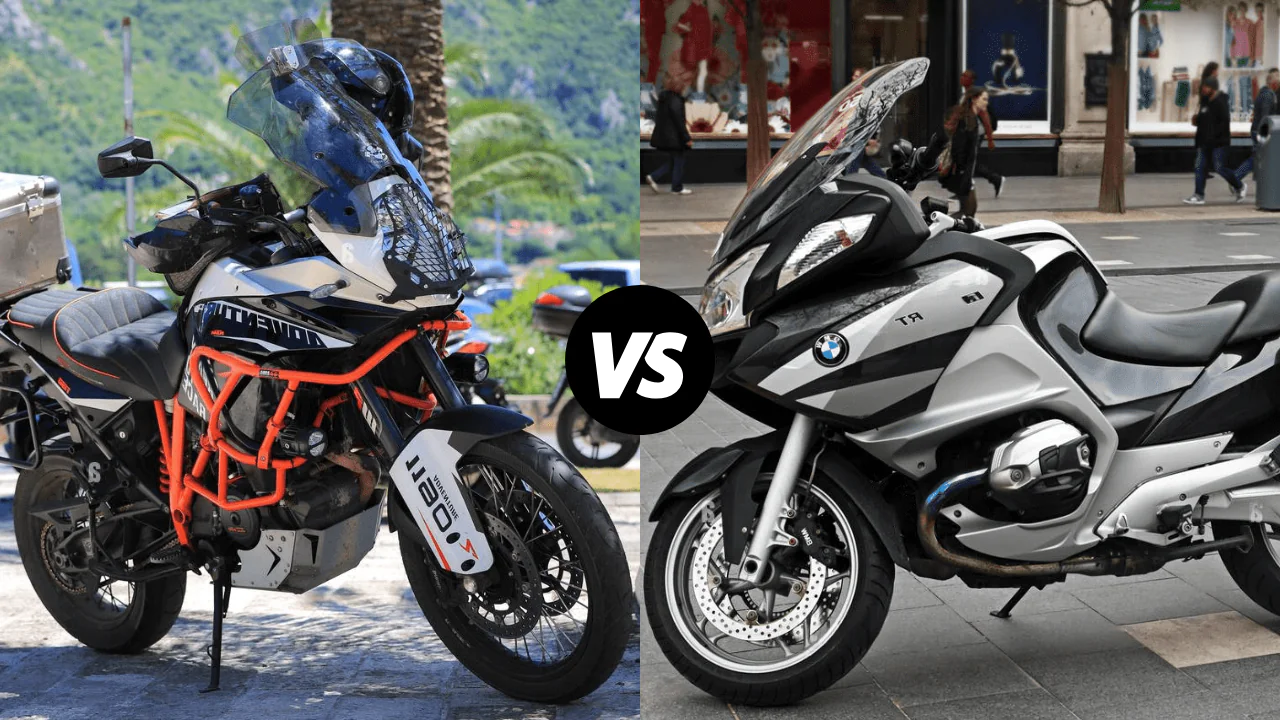Looks like it’s finally time, time for a new motorcycle for exciting adventures. But you have just hit a roadblock, you aren’t able to decide on what type of motorcycle you should buy? An Adventure or maybe a Tourer.
I know it’s not that easy to just take a side, took me more than a year to decide which motorcycle I should buy. Btw if you’re a beginner then this post will help you to decide that – Best Adventure Motorcycles for Beginners.
What to Buy: Adventure or Touring Motorcycle?
Let me not waste your precious time that you’ll just spend scrolling through social media and give you a straight answer real quick.
If you want to ride on both on-road and off-road with ease then go for Adventure Motorcycle, and if you want to have a smooth and comfortable long highway ride with a little offroad on gravel roads then a Tourer is what you should go for.
Differences Between Adventure & Touring Motorcycles
Both Adventure and tourers have some things that are common like both are comfortable and are designed for long-distance riding, but when it comes to differences they have some key differences.
Adventure motorcycles: Also known to many as dual-sport or enduro bikes are built for both on-road and off-road riding. These are typically smaller and lighter than touring motorcycles and generally have high ground clearance, longer suspension, rugged tires, and other features that make these motorcycles suitable for riding on rough trails, gravel roads, and highways with ease.
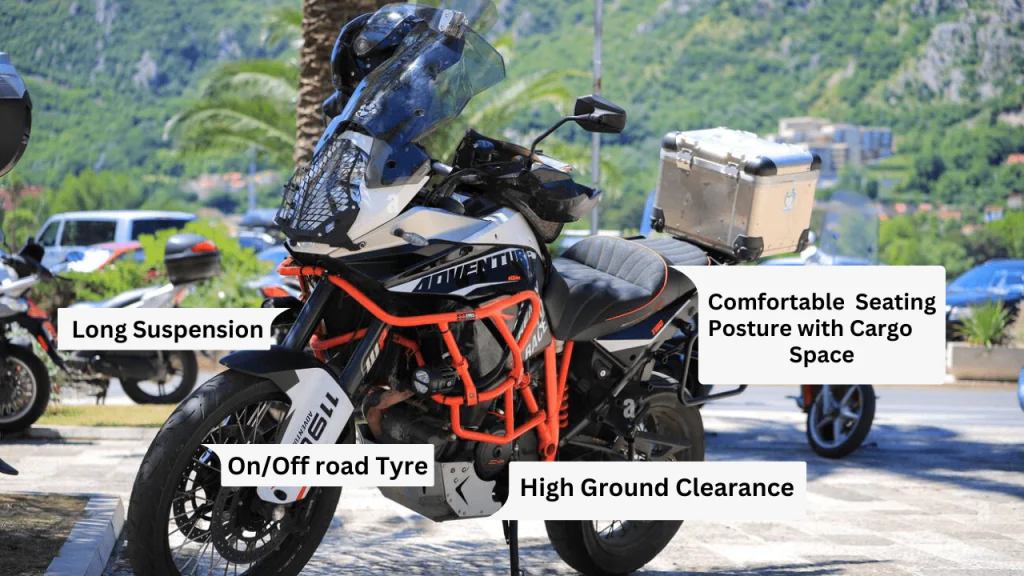
Touring motorcycles: These motorcycles, on the other hand, are designed for long-distance highway travel and are typically larger and more comfortable than adventure motorcycles. They have larger engines, more spacious and comfortable seats, and more storage capacity for luggage and other gear.
Most Touring motorcycles have features like windscreens and fairings to protect the rider from the wind and weather. Some tourer motorcycles also get a full Sound System to listen to music, because why not?
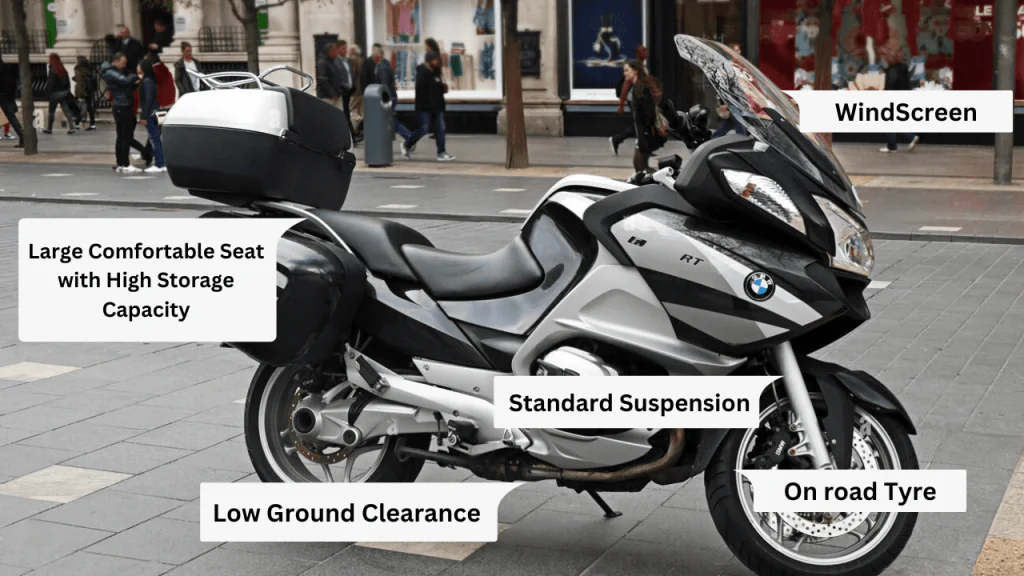
Here are the basic and key differences between an Adventure and Tourer Motorcycle:
| Feature | Adventure Motorcycle | Tourer Motorcycle |
| Purpose | Offroad and Onroad Riding | Long-distance touring on highways |
| Engine | Rugged and durable, with a high torque | High-performance, with a high horsepower output |
| Suspension | Long-travel suspension for off-road riding | Sport-tuned suspension for a smooth and stable ride on highways |
| Tyre | Both off-road and on-road capable tires | Only on-road tires |
| Comfort | Basic seating and limited amenities for a rugged look | Comfortable seating and advanced amenities for long-distance comfort |
| Storage | Limited Storage | Generally Large storage |
| Protection | Engine and body protection from rough terrain | Little protection |
| Weather Protection | Basic weather protection with limited wind and rain protection | Advanced weather protection with heated grips, seats, and windscreen. |
Comparing Adventure and Touring Motorcycle
Now that you know about the basic and key differences between Adventure and tourer motorcycles, let’s compare them both in terms of – Price, Engine, Suspension, Tires, Comfort, Pillion Comfort, Seat Height, Weight, Luggage, Technology, and Versatility.
Price
Adventure motorcycles and touring motorcycles can vary greatly in price, depending on the brand, model, and features of the bike the prices can start anywhere from $2500 in smaller Advs like the Royal Enfield Himalayan to upwards of over $30000 in Tourers like BMW K 1600 GTL.
Generally, adventure motorcycles are typically less expensive compared to touring motorcycles. This is due in part to their smaller size and simpler designs and also higher demand in the market.
The exact price of an adventure motorcycle will depend on the model, features, and brand of the motorcycle, but you can expect it to be anywhere between $2,500 to $15,000.
Some high-end models may cost more, but there are also many affordable options available.
Touring motorcycles on the other hand tend to be more expensive than adventure motorcycles. This is due to their larger size, more complex designs, and additional features, such as windscreens and fairings, and also due to low demand which makes them expensive to build.
The price of touring motorcycles can be anywhere between $10,000 to $25,000 or more, depending on the model, features, and brand.
Engine
Adventure motorcycle engines are generally more powerful and have more torque than touring motorcycles. This is because these motorcycles are designed to handle a more challenging terrain and require more power to do so.
These engines are designed to provide maximum power and torque at low RPMs, which is necessary when navigating steep inclines and uneven terrain.
Tourers have engines that are designed for smooth, comfortable, and efficient rides on paved roads. Most of them get inline-four engines that provide a smooth power delivery throughout the RPM range.
These engines are designed to provide a balance of power and fuel efficiency with more power and torque at higher RPMs, which is useful when cruising on highways and open roads, making them ideal for smooth long-distance rides.
Suspension
Most Adventure motorcycles get long-travel suspension with larger shocks, which provides increased suspension travel for navigating through rough offroad terrain.
This helps absorb the impact of bumps, rocks, and other obstacles, making for a smoother and more controlled ride off-road. Adventure bikes often have adjustable suspension, allowing riders to customize the settings to match the terrain and riding style.
Touring motorcycles get a more traditional suspension setup with short travel and smaller shocks.
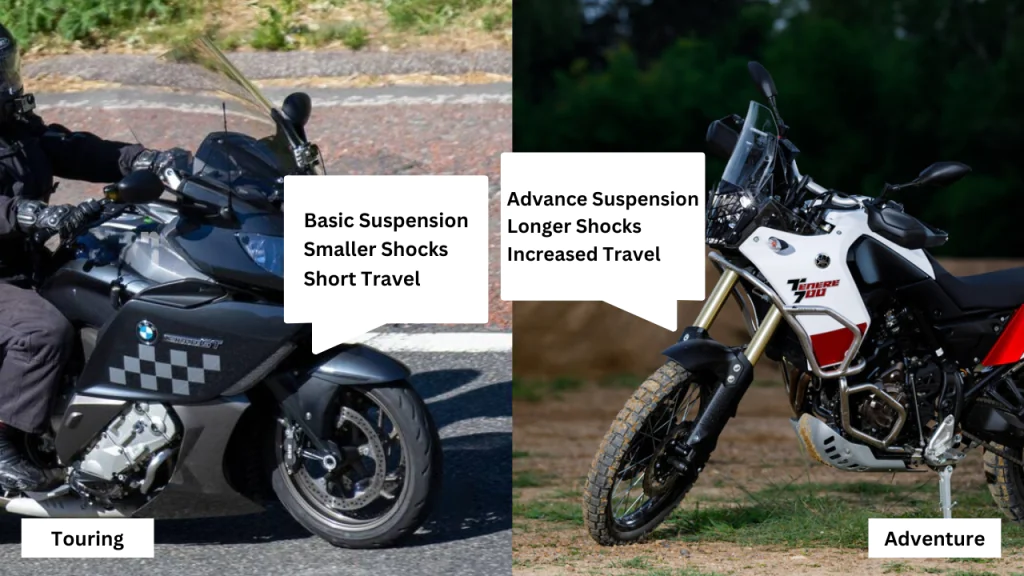
This is because these motorcycles are designed to provide a smooth and comfortable ride on paved highway roads, where long-travel suspension is not necessary.
Tourers also have adjustable suspension, but the settings of the suspension are geared more toward comfort and handling on paved surfaces.
Tires
Adventure motorcycles generally have aggressive tires that are designed for off-road terrain. These tires have a deeper tread pattern and a larger contact patch, which provides better traction on loose gravel, mud, and other uneven surfaces.
These tires are also wider, which provides more stability and grip in off-road conditions.
As tourer motorcycles are more focused towards highway rides they have narrower and smoother tires than adventure motorcycles, for smooth and comfortable rides on paved roads.
These tires are designed for high-speed performance, with a focus on grip, stability, and durability and have shallower tread pattern and a smaller contact patch, which provides better grip and handling on paved surfaces.
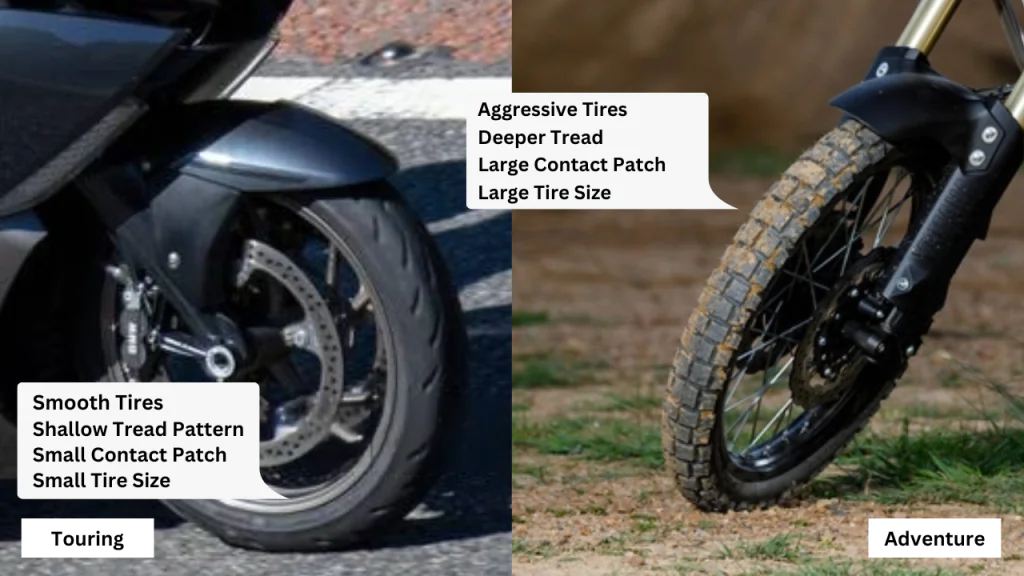
In addition Adventure bike tires generally have lower tire pressure, which provides a softer ride and better traction on uneven surfaces. Compared to tourers which have higher tire pressure, that provides a more responsive ride and better fuel efficiency.
Tire size is also an important factor, adventure bikes typically have larger tires with a diameter of 19-21 inches, which provides better stability and traction in off-road conditions, also bigger tires gives you a smooth ride on the offroad.
Tourers on the other hand have smaller tires with a diameter of 17-18 inches, which provides better handling and stability on paved roads.
Seat and Comfort
In terms of comfort both these types of motorcycles are designed for long-distance riding, but they have different priorities when it comes to comfort.
Adventure motorcycles generally are built for off-road performance and are typically smaller and lighter than the touring motorcycles. They have firm, upright seating positions and narrow seats that can be less comfortable on long rides for some riders.
When it comes to comfort Touring motorcycles win the race, they are typically larger and more comfortable than adventure motorcycles.
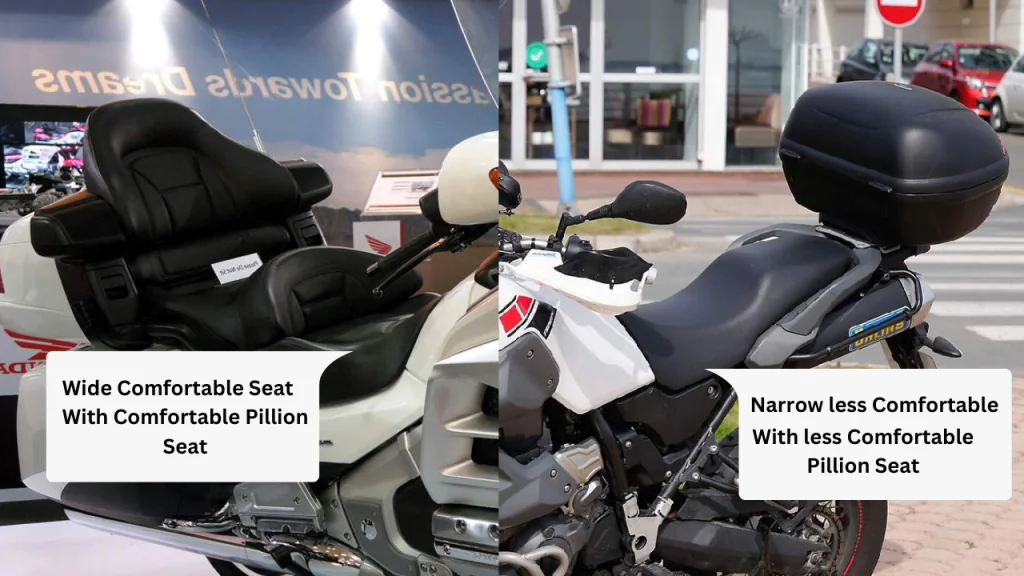
Have wider, more padded seats and a relaxed upright seating position that is designed to reduce fatigue on long rides. Some tourers have such comfortable seats that you’ll feel like you are sitting on a sofa while riding.
Touring motorcycles also often have additional features that can enhance comforts, such as windscreens and fairings that protect the rider from the wind and weather, and heated grips for cold weather.
Pillion Comfort
The comfort of a pillion (passenger) on an adventure motorcycle or touring motorcycle depends on what motorcycle we are talking about but in general adventure motorcycles often have narrow, firm seats that may not be very comfortable for a pillion.
In addition, the upright seating position and rough terrain that adventure motorcycles are designed for can make the ride less comfortable for a pillion, that’s something you have to look for before buying an adv.
But when it comes to touring motorcycles, they are more comfortable than adventure motorcycles, with wider, more padded seats and relaxed seating positions.
This can make them more comfortable for a pillion, especially on long-distance road trips.
Most Touring motorcycles also have additional features that can enhance the comfort of a passenger, such as backrests and footpegs, which can help to distribute the passenger’s weight and reduce fatigue.
Seat Height
As a short person myself I always had problems riding certain types of motorcycles. If you have a height of 5.3ft or lower then you might have some difficulty riding advs as most adventure motorcycles in the market have a seat height higher than 800mm or just around 31 inches.
Adventure motorcycles typically have seat height in the range of 32 to 36 inches, although some models may have higher or lower seat heights.
Seat height is just a little low in tourers compared to adventure. Most Touring motorcycles have seat height in the range of 31 to 35 inches, some models may have higher or lower seat heights.
Some tourer and adventure motorcycles also get adjustable seats which can reduce the seat height by a few inches like 1 – 3 inches. However, this feature is only available in high-end motorcycles not in budget ones.
Weight
Just like seat height, the weight of a motorcycle is also an important thing to consider. As Adventure motorcycles are designed to be ridden offroad they are typically lighter.
This is due to their smaller size and lightweight body, which makes them easier to maneuver off-road and on trails. Most advs weigh between 300 and 600 pounds, although some models may be heavier or lighter.
If you have seen touring motorcycles up close, you know how big and bulky they look, because they are typically more extensive and more heavily built than adventure motorcycles.
This is to make the motorcycle more stable and comfortable on highway roads and wind. Most tourers weigh between 500 and 1,000 pounds, some models may be heavier or lighter.
When choosing between adventure and touring motorcycles it’s important to choose one that has a good power-to-weight ratio.
Luggage
When going on long rides having the ability to carry more luggage is necessary. Adventure motorcycles and touring motorcycles can be both equipped with luggage for carrying gear and other important luggage.
Adventure motorcycles often have limited space for luggage. Some have built-in luggage racks or saddlebags that can carry a small amount of luggage.
But most need high-capacity luggage racks or saddle bags added separately to be able to carry the proper amount.
But when it comes to touring motorcycles they are designed specifically for long-distance road travel and often have spacious and versatile luggage options.
Most of them have built-in hard-sided luggage cases, as well as additional luggage racks and saddlebags for carrying extra gear.
Some touring motorcycles may also have cargo compartments or trunks, which can provide even more storage space for gear.
Technology
As Adventure motorcycles are designed for mainly off-road performance and are focused on providing the rider with control and agility for rough trails and gravel roads.
They get basic technological features such as ABS, Traction Control, Advance Instrument Cluster, and Adjustable Suspension. Also, the less integrated an adventure motorcycle is to technology, the better.
Touring motorcycles however are designed for mainly long-distance road travel and often have more sophisticated technology and features.
These motorcycles have features such as automatic windscreens and fairings, heated grips, Sound systems, GPS navigation systems, ABS brakes, Cruise Control, and traction control that are designed to enhance the rider’s comfort, convenience, and safety on the road.
Versatility
Both adventure and tourer are versatile motorcycles that are suitable for a range of riding styles and conditions.
Adventure motorcycles are smaller and lighter than touring motorcycles which are designed to be agile and capable off-roaders.
These motorcycles can handle a wide range of terrain, from smooth pavement to rough trails, and are often equipped with features like knobby tires and high-clearance suspension that make them well-suited to off-road riding.
Touring motorcycles are designed specifically for long-distance road travel and are larger and more comfortable than adventure motorcycles.
Touring motorcycles can handle extended trips on paved roads and highways, and are often equipped with features like windscreens and fairings that can protect the rider from the wind and weather.
Some touring motorcycles are also capable of light off-road riding, but they are not designed for the same level of off-road performance as adventure motorcycles.
Pros & Cons of Adventure and Touring Motorcycles
Adventure motorcycles and touring motorcycles have their own unique pros and cons. Some of the potential pros and cons of each type of motorcycle are listed below:
| Adventure Motorcycles | Touring Motorcycles |
| Pros | Pros |
| Versatile for off-road and on-road riding | Designed specifically for long-distance road travel |
| Lightweight and agile | Larger and more comfortable for extended rides |
| Excellent suspension and ground clearance for off-road riding | Equipped with features like windscreens and fairings for wind/weather protection |
| Knobby tires for traction on loose terrain | Advanced sound system for entertainment on long rides |
| Anti-lock braking systems and traction control for safety | Cruise control for ease of use on highways |
| Cons | Cons |
| Not as comfortable for extended highway rides | Heavy and less agile for off-road riding |
| Limited storage capacity for luggage | Wind/weather protection can add weight and bulk |
| Off-road performance may require specialized skills and gear | Limited ground clearance can limit off-road capabilities |
| May require more maintenance due to exposure to dirt and debris | Higher cost due to advanced technology and equipment |
| May not be as fuel efficient due to the larger engine size | Limited maneuverability in city traffic |
Conclusion: Should I Buy an Adventure or Touring Motorcycle?
In Conclusion, the right type of motorcycle for you will depend on your riding preferences, the type of terrain you plan to ride on, Or maybe the specs you want on your motorcycle.
If you want a motorcycle that can handle a range of terrain, from smooth pavement to rough trails and that is more agile and versatile in all conditions then go for an adventure motorcycle.
If you want a comfortable and well-equipped bike for extended trips and long-distance road travel and a stable and relaxed riding experience then go for a touring motorcycle.
Consider the pros and cons of each type of motorcycle and choose the one that best fits your needs and riding goals. Happy Riding.
